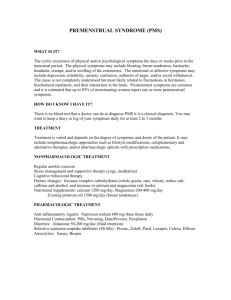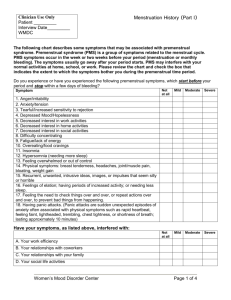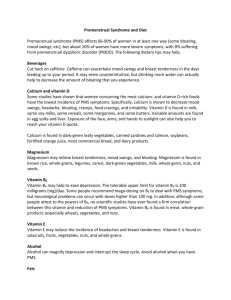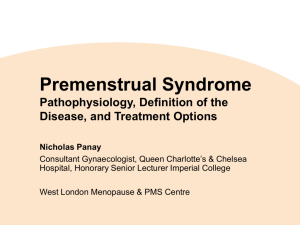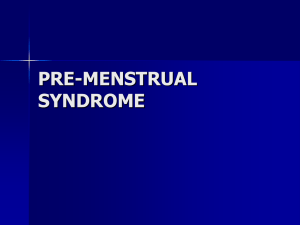Document 13309890
advertisement
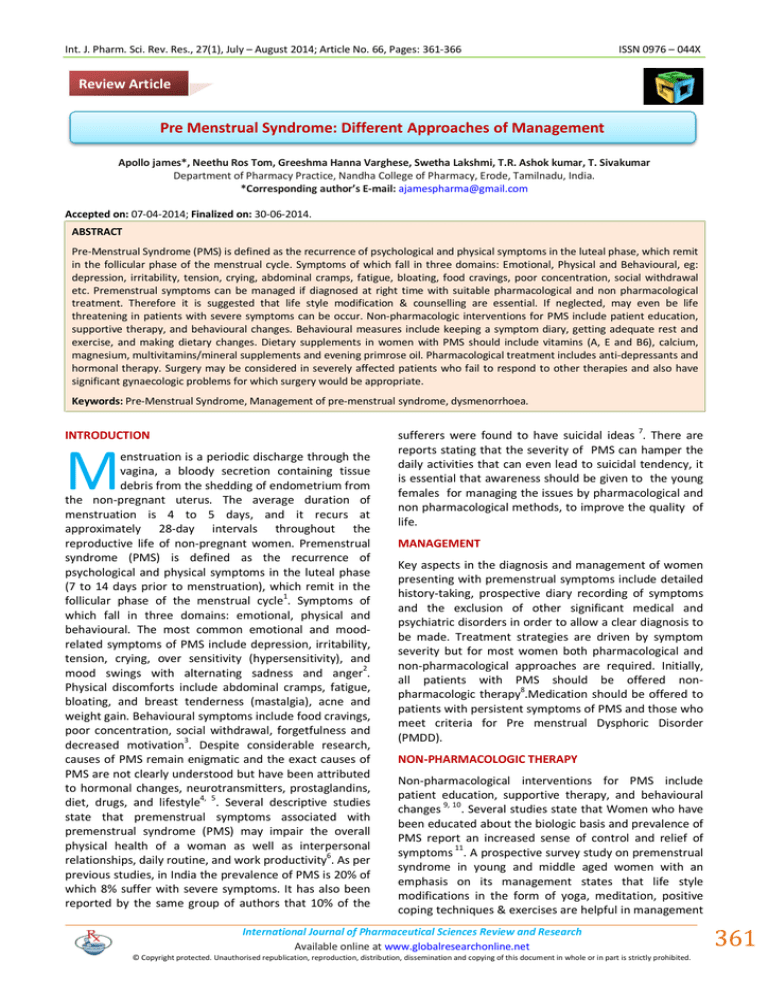
Int. J. Pharm. Sci. Rev. Res., 27(1), July – August 2014; Article No. 66, Pages: 361-366 ISSN 0976 – 044X Review Article Pre Menstrual Syndrome: Different Approaches of Management Apollo james*, Neethu Ros Tom, Greeshma Hanna Varghese, Swetha Lakshmi, T.R. Ashok kumar, T. Sivakumar Department of Pharmacy Practice, Nandha College of Pharmacy, Erode, Tamilnadu, India. *Corresponding author’s E-mail: ajamespharma@gmail.com Accepted on: 07-04-2014; Finalized on: 30-06-2014. ABSTRACT Pre-Menstrual Syndrome (PMS) is defined as the recurrence of psychological and physical symptoms in the luteal phase, which remit in the follicular phase of the menstrual cycle. Symptoms of which fall in three domains: Emotional, Physical and Behavioural, eg: depression, irritability, tension, crying, abdominal cramps, fatigue, bloating, food cravings, poor concentration, social withdrawal etc. Premenstrual symptoms can be managed if diagnosed at right time with suitable pharmacological and non pharmacological treatment. Therefore it is suggested that life style modification & counselling are essential. If neglected, may even be life threatening in patients with severe symptoms can be occur. Non-pharmacologic interventions for PMS include patient education, supportive therapy, and behavioural changes. Behavioural measures include keeping a symptom diary, getting adequate rest and exercise, and making dietary changes. Dietary supplements in women with PMS should include vitamins (A, E and B6), calcium, magnesium, multivitamins/mineral supplements and evening primrose oil. Pharmacological treatment includes anti-depressants and hormonal therapy. Surgery may be considered in severely affected patients who fail to respond to other therapies and also have significant gynaecologic problems for which surgery would be appropriate. Keywords: Pre-Menstrual Syndrome, Management of pre-menstrual syndrome, dysmenorrhoea. INTRODUCTION M enstruation is a periodic discharge through the vagina, a bloody secretion containing tissue debris from the shedding of endometrium from the non-pregnant uterus. The average duration of menstruation is 4 to 5 days, and it recurs at approximately 28-day intervals throughout the reproductive life of non-pregnant women. Premenstrual syndrome (PMS) is defined as the recurrence of psychological and physical symptoms in the luteal phase (7 to 14 days prior to menstruation), which remit in the follicular phase of the menstrual cycle1. Symptoms of which fall in three domains: emotional, physical and behavioural. The most common emotional and moodrelated symptoms of PMS include depression, irritability, tension, crying, over sensitivity (hypersensitivity), and 2 mood swings with alternating sadness and anger . Physical discomforts include abdominal cramps, fatigue, bloating, and breast tenderness (mastalgia), acne and weight gain. Behavioural symptoms include food cravings, poor concentration, social withdrawal, forgetfulness and decreased motivation3. Despite considerable research, causes of PMS remain enigmatic and the exact causes of PMS are not clearly understood but have been attributed to hormonal changes, neurotransmitters, prostaglandins, 4, 5 diet, drugs, and lifestyle . Several descriptive studies state that premenstrual symptoms associated with premenstrual syndrome (PMS) may impair the overall physical health of a woman as well as interpersonal 6 relationships, daily routine, and work productivity . As per previous studies, in India the prevalence of PMS is 20% of which 8% suffer with severe symptoms. It has also been reported by the same group of authors that 10% of the sufferers were found to have suicidal ideas 7. There are reports stating that the severity of PMS can hamper the daily activities that can even lead to suicidal tendency, it is essential that awareness should be given to the young females for managing the issues by pharmacological and non pharmacological methods, to improve the quality of life. MANAGEMENT Key aspects in the diagnosis and management of women presenting with premenstrual symptoms include detailed history-taking, prospective diary recording of symptoms and the exclusion of other significant medical and psychiatric disorders in order to allow a clear diagnosis to be made. Treatment strategies are driven by symptom severity but for most women both pharmacological and non-pharmacological approaches are required. Initially, all patients with PMS should be offered nonpharmacologic therapy8.Medication should be offered to patients with persistent symptoms of PMS and those who meet criteria for Pre menstrual Dysphoric Disorder (PMDD). NON-PHARMACOLOGIC THERAPY Non-pharmacological interventions for PMS include patient education, supportive therapy, and behavioural 9, 10 changes . Several studies state that Women who have been educated about the biologic basis and prevalence of PMS report an increased sense of control and relief of 11 symptoms . A prospective survey study on premenstrual syndrome in young and middle aged women with an emphasis on its management states that life style modifications in the form of yoga, meditation, positive coping techniques & exercises are helpful in management International Journal of Pharmaceutical Sciences Review and Research Available online at www.globalresearchonline.net © Copyright protected. Unauthorised republication, reproduction, distribution, dissemination and copying of this document in whole or in part is strictly prohibited. 361 Int. J. Pharm. Sci. Rev. Res., 27(1), July – August 2014; Article No. 66, Pages: 361-366 of mild symptoms along with dietary supplements in the form of calcium, vitamin B6 & soy isoflavones. Counselling the victims & relatives is more essential so that sufferers gain adequate care and attention and it also help them to 12 overcome the incidence . Behavioural measures include keeping a symptom diary, getting adequate rest and exercise, and making dietary changes. The daily symptom diary may help patients identify optimal times for implementing behavioural and other changes to manage symptom exacerbations. Maintaining a symptom diary helps them to manage PMS or PMDD 13. Sleep disturbances, ranging from insomnia to excessive sleep, are common in women with PMS. A structured sleep schedule with consistent sleep and wake times is recommended, especially during the luteal phase 8. Dietary restrictions and exercise may also be useful in patients with PMS 8, 14. Sodium restriction has been proposed to minimize bloating, fluid retention, and breast swelling and tenderness. Caffeine restriction is recommended because of the association between caffeine and premenstrual irritability and insomnia. Dietary restrictions are often recommended to alleviate the physical and psychological symptoms of PMS. The most common dietary recommendations are to restrict sugar and increase consumption of complex carbohydrates 15. Women who consume a carbohydraterich beverage daily during the late luteal phase experienced mood changes when compared with the women who consumed an iso-caloric beverage. PMS patients consume 275% more refined sugar, 62% more refined carbohydrates, 78% more sodium, 79% more dairy products, 52% less zinc, 77% less magnesium and 53% less iron than women without PMS has been noted between saturated, but not unsaturated, fats in the diet and blood oestrogens levels. Furthermore, women who derive approximately 20% of their calories from fat have significantly lower blood oestrogens levels than women who consumed 40% of their calories as fat 13. Certain studies state that Women who consume large amounts of caffeine are more likely to suffer from PMS. Aerobic exercise Women who have PMS are often encouraged to increase their activity level. In certain prospective control studies, it has been hypothesized that exercise (particularly aerobic varieties) increases endorphin levels, which in turn improves mood15. Several descriptive studies indicate that women who exercise regularly have fewer PMS symptoms than sedentary women. Given the associated benefits of exercise, it seems reasonable to recommend an aerobic exercise program to help alleviate PMS 15, 16 symptoms . Cognitive Behaviour Therapy Cognitive behaviour therapy uses psychotherapy techniques that focus on modifying problematic thoughts, emotions, and behaviours. It appears to be effective for other affective and somatic disorders such as anxiety and ISSN 0976 – 044X pain; thus, it theoretically could be useful for PMS treatment. DIETARY SUPPLEMENTATION Dietary supplements in women with PMS should include vitamins (A, E, and B6), calcium, magnesium, multivitamin/mineral supplements, and evening primrose oil13. Pyridoxine (vitamin B6) Pyridoxine, or vitamin B6, is one of the most widely used and it is the most probable controversial treatment for PMS. Vitamin B6 is believed to correct a deficiency in the hypothalamic-pituitary axis. Vitamin B6 is a cofactor in the synthesis of tryptophan and tyrosine, which are the precursors of serotonin and dopamine, respectively. Theoretically, low levels of vitamin B6 lead to high levels of prolactin that in turn produce the oedema and psychological symptoms associated with PMS. Vitamin B6 can also cause substantial toxicity and unpleasant side effects. In a Randomized Control Trial, A Jacob et al states that Taken at doses as low as 500 mg daily, it can produce a progressive sensory ataxia and can also cause gastrointestinal side effects, particularly nausea17. A daily dose of 200-600 mg, VitaminB6 lowers serum oestrogen and elevates serum progesterone levels. This shift should benefit to those patients who have an elevation of oestrogen in relation to progesterone. The active form of pyridoxine, pyridoxal-5-phosphate, is a co-factor in the formation of the following neurotransmitters; dopamine, serotonin and GABA. Deficiencies of each of these neurotransmitters have been implicated in some symptoms of PMS, particularly depression 18. Evening primrose oil Evening primrose oil is used extensively to alleviate PMS symptoms. Evening primrose oil contains two essential fatty acids: linoleic and γ-linolenic. Some experts suggest that women with PMS are deficient in γ-linolenic acid, which is necessary for prostaglandin formation. Evening primrose oil is generally well tolerated, but occasionally it can produce nausea, dyspepsia, and headache. Long-term use can be associated with increased risk of inflammation, thrombosis, and immunosuppression. Finally, evening 19 primrose oil is relatively expensive . Magnesium Magnesium supplementation seems to be correcting a deficiency. Magnesium status of women with PMS to asymptomatic subjects have no relationship between serum levels of magnesium and premenstrual symptoms but have a significant decrease in Red Blood Cell magnesium levels in PMS patients. A magnesium deficiency causes a depletion of brain dopamine. A deficiency may also cause hyperplasia of the adrenal cortex, elevating aldosterone and contributing to fluid retention. A vicious cycle results as the elevated aldosterone may in turn increase urinary excretion of magnesium. A magnesium deficiency may also interfere International Journal of Pharmaceutical Sciences Review and Research Available online at www.globalresearchonline.net © Copyright protected. Unauthorised republication, reproduction, distribution, dissemination and copying of this document in whole or in part is strictly prohibited. 362 Int. J. Pharm. Sci. Rev. Res., 27(1), July – August 2014; Article No. 66, Pages: 361-366 with essential fatty acid metabolism, as magnesium is necessary for conversion of cis-linoleic to gamma linolenic acid. In certain descriptive studies, Magnesium plays an integral part in all activities of pyridoxine, being necessary for its phosphorylation, the first step in conversion to PLP. High lead levels have been implicated in PMS, magnesium provides benefit by blocking intestinal absorption of lead20. Vitamin E The research first focused upon the effect of vitamin E in alleviating breast symptoms. In a double-blind study there was a significant decrease in some symptoms 19. The physiological mechanisms for vitamin E in the treatment of PMS are not clearly understood. Vitamin E has a role in the modulation of prostaglandin synthesis. Tocopherol reduces release of arachidonic acid from phospholipids, resulting in a decrease in formation of PGE2, or inflammatory prostaglandins. Alpha-tocopherol, which crosses the blood-brain barrier, also has modulating effects on neurotransmitters. Supplementation of vitamin E, for instance, blocks arachidonic acid, induced decrease in GABA. In the study doses of 150-300 IU D,L-alphatocopherol twice daily succeeded in significantly reducing symptoms in three of the four categories (as established by Abraham) of PMS20. Calcium Calcium carbonate should be recommended as first-line therapy for women with mild-to moderate PMS. Studies found calcium supplementation to significantly reduce symptoms of PMS compared to placebo20. Calcium is an essential mineral that activates a wide range of intracellular and extracellular responses including muscle contraction, nerve conduction, glycogen metabolism, cellular differentiation and immune function. Calcium fluxes across cell and plasma membranes and plays a vital role in the secondary messenger system allowing hormone and neurotransmitter release 21. Calcium significantly decreases pain and water retention during the luteal and menstrual phase. Those on a high calcium (1200 mg) diet have fewer premenstrual symptoms related to mood, concentration and behaviour while a low manganese diet (1 mg as opposed to 5.6 mg) seemed to correlate with an increase in premenstrual symptoms. Vitamin D is essential for the absorption of calcium. Vitamin A It is helpful for the treatment of PMS, particularly for premenstrual headaches. Dose as low as 40,000 IU daily over a period of years may be toxic 22. Since recent evidence suggests that administering more than 10,000 IU of supplemental vitamin A per day may increase the risk of teratogenicity, until more is known, dosages above 10,000 IU per day should be avoided in all women 23, 24 capable of conception . ISSN 0976 – 044X Zinc Zinc may be important, as it influences the binding of progesterone to human endometrium. Zinc is also involved with B6 in the synthesis of Gama amino butyric acid (GABA) and is necessary for the formation of Prostaglandin E1(PGE1) from linoleic acid25.Furthermore, zinc is necessary for the mobilization of vitamin A from the liver, so supplementation may decrease the necessary therapeutic dose of vitamin A . At doses of 50 mg daily, zinc may inhibit prolactin levels, an elevation of which may result in depressed progesterone 26. Flavonoids One hundred sixty-five women were treated with Endotelon, a standardized grape seed oligomeric proanthocyanidin (OPC). Significant improvement was noted with the use of flavonoids. After two cycles, there was 60.8% improvement and after four cycles, a 78.8% improvement in abdominal swelling, mammary symptoms, pelvic pain27, 28. Flavonoids such as apigenin and quercetin inhibit the synthesis of human oestrogen in vitro and may do so in vivo by competing with oestrogen substrates29. Pharmacological treatments for PMS Hormonal interventions Long-acting gonadotropin-releasing hormone (GnRH) agonists are effective but results in medical menopause with its accompanying symptoms, which leads women at risk for osteoporosis30. Approximately 60% to 70% of women with PMDD respond to leuprolide (a GnRH agonist), but it is difficult to predict who will respond; daily mood self-ratings of sadness, anxiety, and irritability predict a positive response to leuprolide with high probability32, 33. Side effects of GnRH agonists (hot flashes, night sweats, vaginal dryness, etc.) can be tempered by “adding back” some oestrogen with a hormonal agent with progestational activity to reduce the risks of unopposed oestrogen (i.e., endometrial hyperplasia) 34. Antidepressants Antidepressants effectively ameliorate affective and physical symptoms and improve quality of life and psychosocial function in patients with PMS and PMDD. These include: Tricyclic antidepressants such as clomipramine, SSRIs, citalopram, escitalopram, fluoxetine, paroxetine, and sertraline, serotonin-noradrenergic reuptake inhibitor venlafaxine35. Dosing antidepressants only in the luteal phase (taking the antidepressant from ovulation onset to the start of menses) is an effective treatment strategy. All serotonergic antidepressants which have been studied, found to be more effective than placebo with an average response rate of approximately 60% in double blind placebo control trials. Selective serotonin reuptake inhibitors can be considered as firstline therapy for women with severe affective symptoms and for women with milder symptoms who have failed to .36, 37 respond to other therapies . Nonserotonergic International Journal of Pharmaceutical Sciences Review and Research Available online at www.globalresearchonline.net © Copyright protected. Unauthorised republication, reproduction, distribution, dissemination and copying of this document in whole or in part is strictly prohibited. 363 Int. J. Pharm. Sci. Rev. Res., 27(1), July – August 2014; Article No. 66, Pages: 361-366 antidepressants such as maprotiline and desipramine have been less helpful in comparison with SSRIs. SSRIs given in the half of the cycle can be as effective as continuous daily dosing. In the case of citalopram, halfcycle dosing was better than continuous dosing. Women with PMS may have decreased serotonergic activity across the menstrual cycle as a trait, and during the lutealphase.Other medications include anxiolytics like Alprazolam & Bromocriptine for decreasing breast tenderness.An extensive review by Andersch, which analyzed 14 randomized controlled trials until 1982, found no improvement in general PMS symptoms compared with placebo. One exception was severe cyclic mastalgia, for which bromocriptine might be effective38,39. High-dose oestrogen as transdermal patches or subcutaneous implants to inhibit ovulation is effective, but because of the risks of unopposed oestrogen, a progestin would be needed. Risks of oestrogen therapy (alone and in combination with progestins) include increased risk of endometrial cancer, coronary heart disease, breast cancer, stroke, and pulmonary 40, 41 embolism . Danazol, a synthetic androgen and gonadotropin inhibitor, effectively block ovulation, but cause side effects include hirsutism and possible teratogenicity42. The use of combined oral contraceptives (oestrogen and progestin) is common. A combination oral contraceptive, drospirenone/ethinyl estradiol, is FDAapproved for treating PMDD in women seeking hormonal contraception because it has shown efficacy compared with placebo, with reported improvements in perceived productivity, social activities, and interpersonal relationships 43, 44. Spironolactone Spironolactone, the potassium-sparing diuretic with antiandrogenic effects, significantly improved symptoms of breast tenderness, bloating, weight gain, and depressed mood compared with placebo, and physicians may consider it as a pharmacologic option for treating PMS symptoms.45, 46. In double blind cross over Randomized Control Trial using spironolactone resulted in 46 improvement in mood for 80% of treated cycles . Symptoms Treatment Swelling Spironolactone 100mg/d po; Start at midcycle (days 12 to 16), magnesium (360mg/day) Pain Mefenamic acid (500mg tid) start at 16 day in cycle or start at PMS symptoms Perimenstrual Symptoms Treat with hormonal therapies, Estradiol patch(0.1 or 0.2 mcg patches for 2 weeks +medroxyprogesterone acetate(5mg from th th 17 to 25 day) Affective symptoms Fluoxetine(20 mg daily po) Sertraline (50 mg daily po) Fluvoxamine (50 mg daily po) Mastalgia Treat with primrose oil three to four times daily General Vitamin B6(50 mg once or twice daily) Vitamin E(400 IU Daily) Surgical treatment, principally hysterectomy plus bilateral oophorectomy, is controversial because it is irreversible and associated with significant risks. Surgery may be considered in severely affected patients who failed to respond to other therapies and also have significant gynaecologic problems for which surgery would be appropriate. th Surgical bilateral ophorectomy is effective but extremely invasive, especially in younger women in whom removal of ovaries generally is inadvisable. Patients should receive a trial of a GnRH agonist before a surgical intervention, because oophorectomy may not reduce symptoms and is irreversible. Oophorectomy also would require hormone replacement therapy. CONCLUSION PMS symptoms can have debilitating effects on women's quality of life and work production. A well developed education program will help in increasing knowledge and decreasing the severity of symptoms of PMS. Clinical Pharmacists can improve the recognition and management of these common conditions by providing patient education on premenstrual symptoms and counselling women on lifestyle interventions and pharmacotherapy to relieve their discomfort. REFERENCES 1. Carol A. H., PMS: diagnosis, aetiology, assessment and management, Revisiting Premenstrual syndrome, Advances in Psychiatric Treatment, 13, 2007, 139-146. 2. Janita P.C. Anne M.C., Effects of an educational programme on adolescents with premenstrualsyndrome, Oxford Journals, 14(6), 1998, 817-830. 3. Shruti Brahmbhatt, B.M.Sattigeri, Heena Shah, Ashok Kumar, Devang Parikh. Department of Pharmacology, Sumandeep Vidyapeeth’s, A prospective survey study on premenstrual syndrome in young and middle aged women with an emphasis on its management, International Journal of Research in Medical Sciences, 1(2), 2013, 69-72. 4. Myint TH, Edessa OG, Sawhsarkapaw. Premenstrual syndrome among female university students in Thailand. AU JT, 9, 2006, 158-62. 5. Rasheed P, Al-sowielem LS. Prevalence and predictors of premenstrual syndrome among college-aged women in Saudi Arabia.Annals of Saudi Medicine, 6, 2003, 381-7. 6. Dean, B. B., & Borenstein, J. E, A prospective assessment investigating the relationship between work productivity NONSTEROIDAL ANTI-INFLAMMATORY DRUGS In Double-blind crossover RCT with 39 participants shows that Mefenamic acid improved general symptoms such as tension, irritability, depression and pain where as Mire et al studies states that Significant improvement in fatigue (P < 0.001), general malaise (P < 0.001), headache (P < 0.005), irritability (P < 0.01), and depressed mood (P < 0.01). No improvement in breast symptoms, swelling 47. ISSN 0976 – 044X International Journal of Pharmaceutical Sciences Review and Research Available online at www.globalresearchonline.net © Copyright protected. Unauthorised republication, reproduction, distribution, dissemination and copying of this document in whole or in part is strictly prohibited. 364 Int. J. Pharm. Sci. Rev. Res., 27(1), July – August 2014; Article No. 66, Pages: 361-366 and impairment with premenstrual syndrome. Journal of Occupational and Environmental Medicine, 46(7), 2004, 649-656. 7. Joshi JV, Pandey SN, Galvankar P, Gogate JA. Prevalence of premenstrual symptoms: preliminary analysis and brief review of management strategies. Journal of mid-life health, 1, 2010, 30-4. 8. Pearlstein, T. B, Non-pharmacologic treatment of the premenstrual syndrome. Psychiatric Annals, 26,1998, 590– 594. & Stone, A. B, Premenstrual syndrome. The Psychiatric Clinics of North America, 21,1998, 577–590. 9. Wyatt K, Dimmock PW, O’Brien PM. Premenstrual syndrome. In: Barton S, ed. Clinical evidence. British medical journal, 4, 2000, 1121-33. 10. Moline ML, Zendell SM. Evaluating and managing premenstrual syndrome. Medscape Womens Health, 5, 2000, 1-16. 11. Lisa M, Alice D, Vittorio K , Fabrizio J , EduardoF , Maurizio T. Perimenstrual Symptom Prevalence Rates: An ItalianAmerican Comparison. American Journal of Epidemiology. 138 (12), 1993, 1070-1081. 12. Pearlstein T, Steiner M. Premenstrual dysphoric disorder: burden of illness and treatment update. J Psychiatry Neurosci, 33, 2008, 291-301 . 13. Lori M. Dickerson, Pamela J. Mazyck and Melissa H. Hunter, Premenstrual Syndrome. American Family Physician, 67, 2003, 1735. 14. Kessel B. Premenstrual syndrome. Advances in diagnosis and treatment. Obstet Gynecol Clin North Am, 27, 2000, 625-39. 15. Sue Douglas, MD, CCFP, Premenstrual syndrome, Evidencebased treatment in family practice, Canadian Family Physician, 48, 2002. 16. Steege JF, Blumenthal JA. The effects of aerobic exercise on premenstrual symptoms in middleaged women: a preliminary study. J Psychosom Res, 37, 1993, 127-33. ISSN 0976 – 044X 22. Rothman KJ, Moore LL, Singer MR, Teratogenicity of high vitamin A intake. N, Engl J Med, 333, 1995,1369-1373. 23. Block E. The use of vitamin A in the premenstrual tension. Acta Obst Gynec Scand, 39, 1960, 586-592. 24. Kleine HO. Vitamin A therapie bei pra menstruellen nervosen Beschwerden. Dtsch Med Wschr, 79, 1954, 879880. 25. Abraham GE. Role of nutrition in managing the premenstrual tension syndromes. J Reprod Med, 32(6), 1987, 405-422. 26. Stewart A. Clinical and biochemical effects of nutritional supplementation on the premenstrual syndrome. J Reprod Med, 32(6), 1987, 435-441. 27. Ruh MF, Zacharewski T, Connor K, Naringenin: a weakly oestrogenic bioflavonoid that exhibits antioestrogenic activity.BiochemPharmacol, 50(9), 1995, 1485-1493. 28. Amsellem M, Endotelon in the treatment of venolymphatic problems in premenstrual syndrome, Multicenter study on 165 patients. Tempo Medical, 4, 1987, 282. 29. Kellis Jr JT, Vickery LE. Inhibition of human oestrogen synthetase (aromatase) by flavones and Science, 255, 1984, 1032-1034. 30. Sundstrom I, Nyberg S, Bixo M, Hammarback S,Backstrom T. Treatment of premenstrual syndrome with gonadotropin-releasing hormone agonist in a low dose regimen. Acta Obstet Gynecol Scand, 78, 1999, 891-9. 31. Wyatt K, Dimmock PW, Jones P, Obhrai M, O’BrienS. Efficacy of progesterone and progestogens in management of premenstrual syndrome: systematic review. BMJ, 323, 2001, 776-80. 32. Rossouw JE, Anderson GL, Prentice RL, et al. Risks and benefits of oestrogen plus progestin in healthy postmenopausal women: principal results from the Women’s Health Initiative randomized controlled trial. JAMA. 288(3), 2002, 321-333. 17. Wyatt KM, Dimmock PW, Jones PW, O’Brien PM. Efficacy of vitamin B-6 in the treatment of premenstrualsyndrome: systematic review. BMJ, 318, 1999, 1375-81. 33. Wyatt KM, Dimmock PW, Ismail KM, et al. The effectiveness of GnRHa with and without ‘add-back’ therapy in treating premenstrual syndrome: a meta analysis. BJOG. 111(6), 2004, 585-593 18. London RS, Sundaram GS, Murphy L,Goldstein PJ. Evaluation and treatment of breast symptoms in patients with the premenstrual syndrome. J Reprod Med, 28(8), 1983, 503. 34. Leather AT, Studd JW, Watson NR, Holland EF. The treatment of severe premenstrual syndrome with and without “add-back” oestrogen therapy: a placebocontrolled study. Gynecol Endocrinol, 13,1999,48-55. 19. London RS, Sundaram G, Manimekalai S, et-al. The effect of alpha-tocopherol on premenstrual symptomatology: A double-blind trial. JAm Coll Nutr 2, 1983, 115-122. 35. Dimmock PW, Wyatt KM, Jones PW, O’Brien PM.Efficacy of selective serotonin-reuptake inhibitors in premenstrual syndrome: a systematic review. Lancet, 356, 2000, 1131-6. 20. Thys-Jacobs S, Ceccarelli S, Bierman A, Weisman H, Cohen M, Alvir J. Calcium supplementation in premenstrual syndrome: a randomised crossover trial. General Internal Medicine, 4, 1989, 183-9. 36. Freeman EW, Rickels K, Sondheimer SJ, Polansky M. A double-blind trial of oral progesterone, alprazolam and placebo in treatment of severe premenstrual syndrome. JAMA, 274, 1995, 51-7. 21. Thys-Jacobs S, Starkey P, Bernstein D, Tian J. Calcium carbonate and the premenstrual syndrome:effects on premenstrual and menstrual symptoms.Premenstrual Syndrome Study Group. Am J Obstet Gynecol, 179, 1998, 444-52. 37. Freeman EW, Rickels K, and Sondheimer SJ, Plansky M. Differential response to antidepressants in women with premenstrual syndrome / premenstrual dysphoric disorder: randomised controlled trial. Archives of General Psychiatry, 56(10), 1999, 932-938. International Journal of Pharmaceutical Sciences Review and Research Available online at www.globalresearchonline.net © Copyright protected. Unauthorised republication, reproduction, distribution, dissemination and copying of this document in whole or in part is strictly prohibited. 365 Int. J. Pharm. Sci. Rev. Res., 27(1), July – August 2014; Article No. 66, Pages: 361-366 38. Andersch B. Bromocriptine and premenstrual syndrome: a survey of double-blind trials. Obstet Gynecol Surv, 38, 1983, 643-6. 39. Meden-Vrtovec H, Vujic D. Bromocriptine in the management of premenstrual syndrome. Clin Exp Obstet Gynecol, 19(4), 1992,242-8. 40. Backstrom T, Andreen L, Birzniece V, Bjorn I, Johansson I,Nordenstam-Haghjo M, et al.The role of hormone and hormonal treatments in premenstrual syndrome. CNS Drugs, 17(5), 2003,325-342. 41. Watson NR, Studd JW, Savvas M, Garnett T, Baber RJ. Treatment of severe premenstrual syndrome with oestradiol patches and cyclical oral norethisterone. Lancet, 2, 1989, 730-2. 42. Hahn PM, Van Vugt DA, Reid RL. A randomized, placebocontrolled, crossover trial of danazol for the treatment of premenstrual syndrome. Psychoneuroendocrinology. 20(2), 1995, 193-209. ISSN 0976 – 044X 43. Smith RN, Studd JW, Zamblera D, Holland EF. A randomised comparison over 8 months of 100 micrograms and 200 micrograms twice weekly doses of topical oestradiol in the treatment of severe premenstrual syndrome. Br J Obstet Gynecol, 102, 1995,475-84. 44. Dalton K. The premenstrual syndrome and progesterone therapy. Chicago, Ill: Year Book Medical Publisher, 2, 1984,87-91. 45. O’Brien PM, Craven D, Selby C, Symonds EM. Treatment of premenstrual syndrome by spironolactone. Br J Obstet Gynaecol, 86, 1979, 142-7. 46. Vellacott ID, Shroff NE, Pearce MY, Stratford ME, Akbar FA. A double-blind, placebo-controlled evaluation of spironolactone in the premenstrual syndrome. Curr Med Res Opin 10, 1987, 450-6. 47. Wood C, Jakubowicz D. The treatment of premenstrual symptoms with mefenamic acid. Br J Obstet Gynecol, 87, 1980, 627-30. Source of Support: Nil, Conflict of Interest: None. International Journal of Pharmaceutical Sciences Review and Research Available online at www.globalresearchonline.net © Copyright protected. Unauthorised republication, reproduction, distribution, dissemination and copying of this document in whole or in part is strictly prohibited. 366
